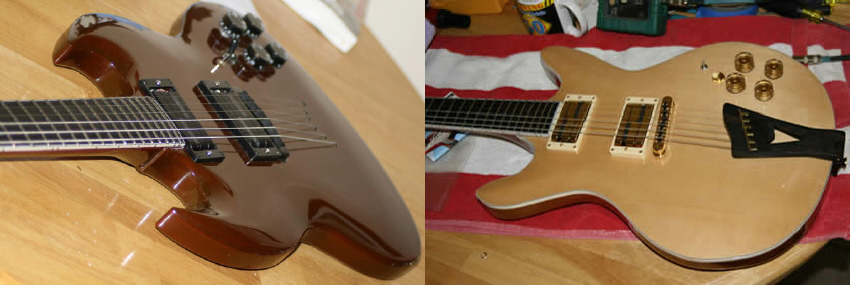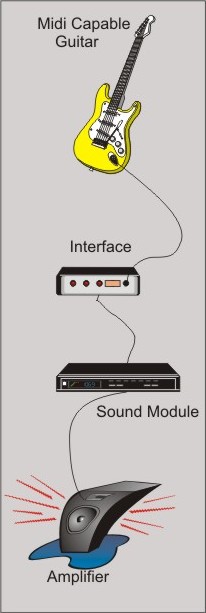The Basics of Midi Guitar
Using the guitar to play piano, organ, bass, brass, woodwinds, effects, and other string instrument sounds is the main function of guitar midi. Guitar midi can also be used with computer software to score music as it is played or input directly into digital recording software. Guitar Midi allows the guitarist to the achieve sounds and functions that in the past were only available to the keyboard player.
Guitar midi currently consists of three separate areas, the hex pickup (divided pickup), the midi interface, and the sound module.
The hex pickup currently comes in two flavors magnetic and piezo. At this point magnetic pickups only come as an aftermarket add on as in the Roland GK-2 or the axon aix-101, both of these pickups can be installed as a temporary addition (non destructive using two sided tape) or can be permanently attached using screws.
Piezo hex pickups commonly come in independent bridge saddles or complete bridge assemblies. Currently the companies that provide this equipment are Graphtech, L.R. Baggs, Schaller, and RMC.
In addition to the midi output many hex pickups can also give your guitar an acoustic sound. The acoustic sound can be used separately or blended with your magnetic pickups, and your midi output. So essentially you can have an acoustic guitar sound, an electric guitar sound, and keyboard synth sounds playing all at the same time.
After the hex pickup you need some form midi interface. The midi interface receives the performance information from the pickup and converts the pitch, duration, and dynamics to digital. This information is then sent to a sound module to apply the synth sounds.
Again here we have the two major flavors of interface units. Interface units such as the Roland GI-20 and the Axon AX-50 both convert the performance information and let you supply an external sound module.
The stand alone units are the Roland GR-33 and the Axon AX-100. Both of these units have the interface and the tone generator built into a single unit. With these units you have the all in one approach to guitar midi. Both of these units have the interface and hundreds of sounds to choose from.
Many tone generators or sound modules are separate units made by various companies. A few notable are Yamaha, Roland, Korg, Moog, Waldorf Blofeld and Muse. There are many more but the type of tone generator is a matter of personal preference and budget.
With guitar midi you can play guitar by yourself and enjoy the full and rich sound of multiple instruments. Guitar midi allows the home studio guitarist to apply a variety of instruments and effects to recordings. With computer software you can quickly score music directly into your computer as you perform and print it out.
Using guitar midi in public performance lets the soloist and the small ensemble provide a greater diversity and richness of sound to their audience. A Midi Guitar can be a serious tool for performing professionals as well as home studio guitarists.


